
Bioluminescence is the production and emission of light by living organisms. It is a form of chemiluminescence. Bioluminescence occurs widely in marine vertebrates and invertebrates, as well as in some fungi, microorganisms including some bioluminescent bacteria, and terrestrial arthropods such as fireflies. In some animals, the light is bacteriogenic, produced by symbiotic bacteria such as those from the genus Vibrio; in others, it is autogenic, produced by the animals themselves.

Luciferin is a generic term for the light-emitting compound found in organisms that generate bioluminescence. Luciferins typically undergo an enzyme-catalyzed reaction with molecular oxygen. The resulting transformation, which usually involves breaking off a molecular fragment, produces an excited state intermediate that emits light upon decaying to its ground state. The term may refer to molecules that are substrates for both luciferases and photoproteins.
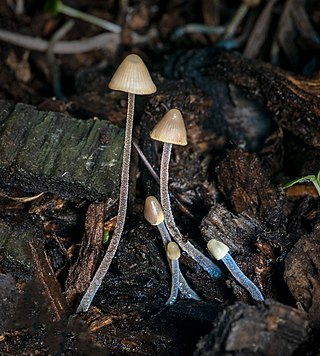
Mycena is a large genus of small saprotrophic mushrooms that are rarely more than a few centimeters in width. They are characterized by a white spore print, a small conical or bell-shaped cap, and a thin fragile stem. Most are grey or brown, but a few species have brighter colours. Most have a translucent and striate cap, which rarely has an incurved margin. The gills are attached and usually have cystidia. Some species, like Mycena haematopus, exude a latex when the stem is broken, and many species have a chlorine or radish-like odour.

Omphalotus nidiformis, or ghost fungus, is a gilled basidiomycete mushroom most notable for its bioluminescent properties. It is known to be found primarily in southern Australia and Tasmania, but was reported from India in 2012 and 2018. The fan or funnel shaped fruit bodies are up to 30 cm (12 in) across, with cream-coloured caps overlain with shades of orange, brown, purple, or bluish-black. The white or cream gills run down the length of the stipe, which is up to 8 cm (3 in) long and tapers in thickness to the base. The fungus is both saprotrophic and parasitic, and its fruit bodies are generally found growing in overlapping clusters on a wide variety of dead or dying trees.
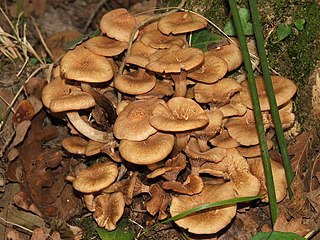
Armillaria tabescens is a species of fungus in the family Physalacriaceae. It is a plant pathogen. The mycelium of the fungus is bioluminescent.

Armillaria sinapina is a species of mushroom in the family Physalacriaceae. A plant pathogenic fungus, it causes Armillaria root disease, and has been found on a variety of tree hosts in Alaska. The mycelium of the fungus is bioluminescent.

Mycena haematopus, commonly known as the bleeding fairy helmet, the burgundydrop bonnet, or the bleeding Mycena, is a species of fungus in the family Mycenaceae, of the order Agaricales. It is widespread and common in Europe and North America, and has also been collected in Japan and Venezuela. It is saprotrophic—meaning that it obtains nutrients by consuming decomposing organic matter—and the fruit bodies appear in small groups or clusters on the decaying logs, trunks, and stumps of deciduous trees, particularly beech. The fungus, first described scientifically in 1799, is classified in the section Lactipedes of the genus Mycena, along with other species that produce a milky or colored latex.

Mycena polygramma, commonly known as the grooved bonnet, is a species of mushroom in the family Mycenaceae. The inedible fruit bodies are small, pale gray-brown mushrooms with broadly conical caps, pinkish gills. They are found in small troops on stumps and branches of deciduous and occasionally coniferous trees. The mushroom is found in Asia, Europe, and North America, where it is typically found on twigs or buried wood, carrying out its role in the forest ecosystem by decomposing organic matter, recycling nutrients, and forming humus in the soil. M. polygramma contains two uncommon hydroxy fatty acids and is also a bioluminescent fungus whose intensity of light emission follows a diurnal pattern.
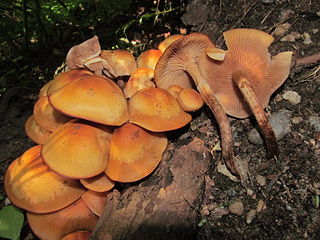
Armillaria nabsnona is a species of fungus in the family Physalacriaceae. The species is found in the west coast of North America, Hawaii, and Japan, where it grows on decaying hardwoods, particularly species of alder. Its fruit bodies have convex to flattened orange-brown caps up to 7 cm in diameter, brown stipes, and whitish to pinkish-tan gills.

Panellus stipticus, commonly known as the bitter oyster, the astringent panus, the luminescent panellus, or the stiptic fungus, is a species of fungus in the family Mycenaceae, and the type species of the genus Panellus. A common and widely distributed species, it is found in Asia, Australia, Europe, and North America, where it grows in groups or dense overlapping clusters on the logs, stumps, and trunks of deciduous trees, especially beech, oak, and birch. During the development of the fruit bodies, the mushrooms start out as tiny white knobs, which, over a period of one to three months, develop into fan- or kidney-shaped caps that measure up to 3 cm (1.2 in) broad. The caps are orange-yellow to brownish, and attached to the decaying wood by short stubby stalks that are connected off-center or on the side of the caps. The fungus was given its current scientific name in 1879, but has been known by many names since French mycologist Jean Bulliard first described it as Agaricus stypticus in 1783. Molecular phylogenetic analysis revealed P. stipticus to have a close genetic relationship with members of the genus Mycena.
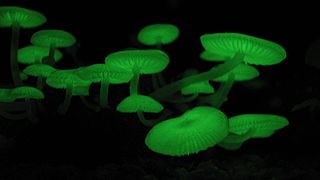
Mycena chlorophos is a species of agaric fungus in the family Mycenaceae. First described in 1860, the fungus is found in subtropical Asia, including India, Japan, Taiwan, Polynesia, Indonesia, and Sri Lanka, in Australia, and Brazil. Fruit bodies (mushrooms) have pale brownish-grey sticky caps up to 30 mm (1.2 in) in diameter atop stems 6–30 mm (0.2–1.2 in) long and up to a millimeter thick. The mushrooms are bioluminescent and emit a pale green light. Fruiting occurs in forests on fallen woody debris such as dead twigs, branches, and logs. The fungus can be made to grow and fruit in laboratory conditions, and the growth conditions affecting bioluminescence have been investigated.
Mycena asterina is a species of agaric fungus in the family Mycenaceae. It is found in São Paulo state, Brazil, where it grows singly or scattered on fallen leaves in Atlantic forests. The fruit bodies of the fungus are bioluminescent.

Mycena tintinnabulum is a European species of agaric fungus in the family Mycenaceae. The mycelium, but not the fruit body, is bioluminescent.
Mycena sublucens is a species of agaric fungus in the family Mycenaceae. Found in Indonesia, it was described as new to science in 1954 by English mycologist E. J. H. Corner. The fruit bodies are bioluminescent.
Mycena pseudostylobates is a species of agaric fungus in the family Mycenaceae. It is bioluminescent. It was originally found on the leaves of Quercus gilva in Japan.
Mycena noctilucens is a species of agaric fungus in the family Mycenaceae. The species was first described scientifically by E.J.H. Corner in 1954. Found in Malaysia and the Pacific islands, the mycelium of the fungus is bioluminescent.

Mycena manipularis is a species of agaric fungus in the family Mycenaceae. Found in Australasia, Malaysia, and the Pacific islands, the mycelium and fruit bodies of the fungus grow in forests and can be bioluminescent. The fruiting bodies also display a variety of morphologies that have no current genetic attributions. References to Mycena manipularis can be found in Japanese folklore and Indonesian food culture.
Nothopanus noctilucens is a species of agaric fungus in the family Marasmiaceae. Found in Japan, the fruit bodies of the fungus are bioluminescent.
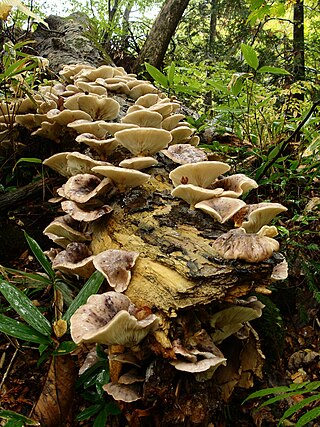
Omphalotus japonicus, commonly known as the tsukiyotake(月夜茸), is an orange to brown-colored gilled mushroom native to Japan and Eastern Asia. It is a member of the cosmopolitan genus Omphalotus, the members of which have bioluminescent fruit bodies which glow in darkness. A 2004 molecular study shows it to be most closely related to a clade composed of Omphalotus nidiformis of Australia, Omphalotus olivascens of Western North America and Omphalotus olearius of Europe.













